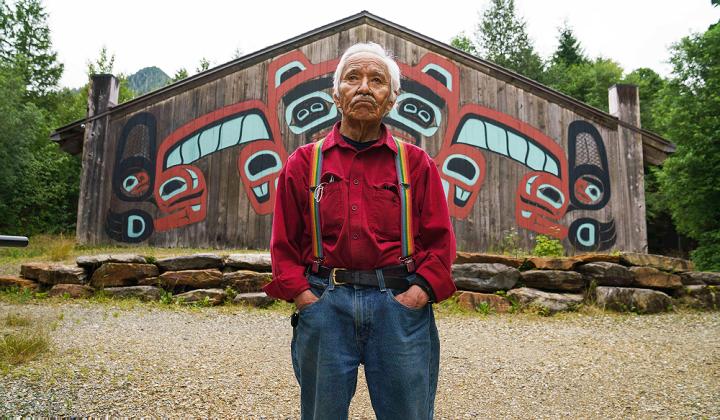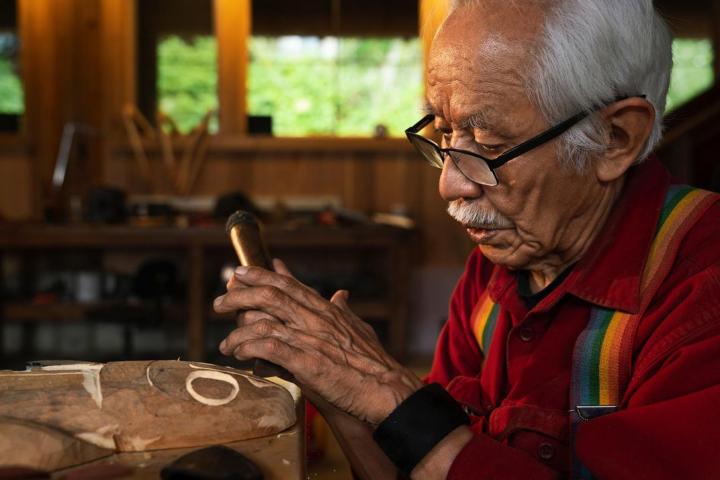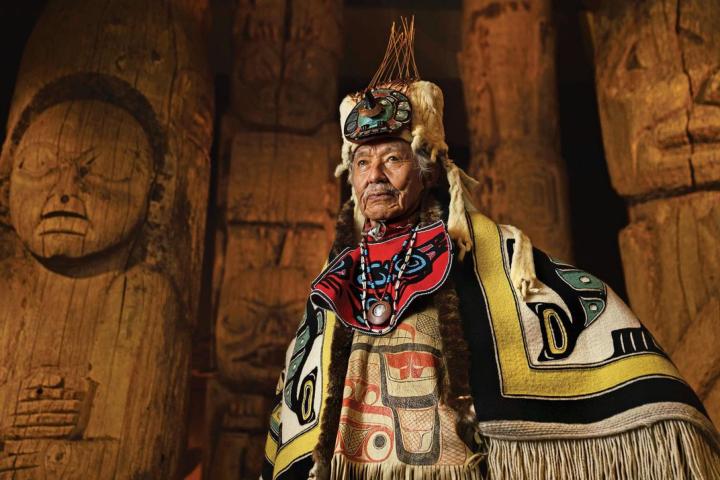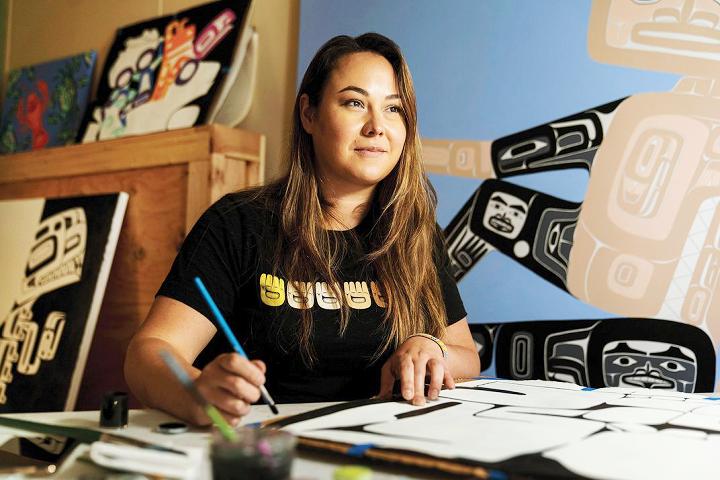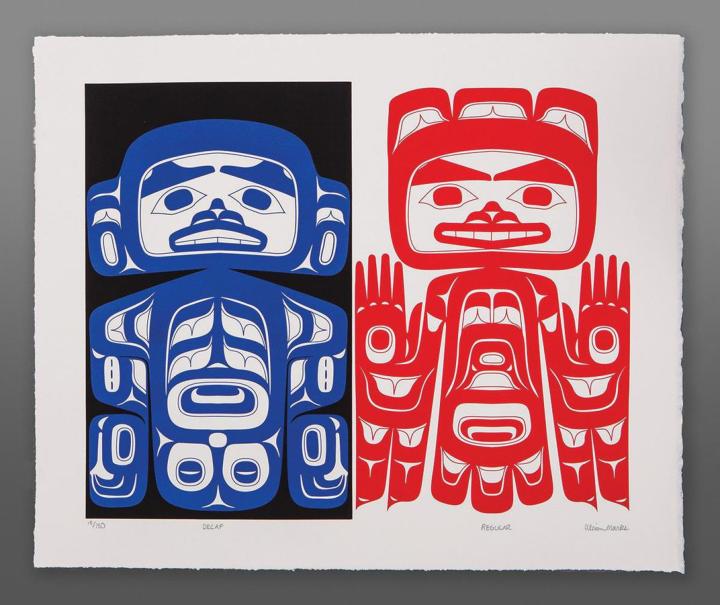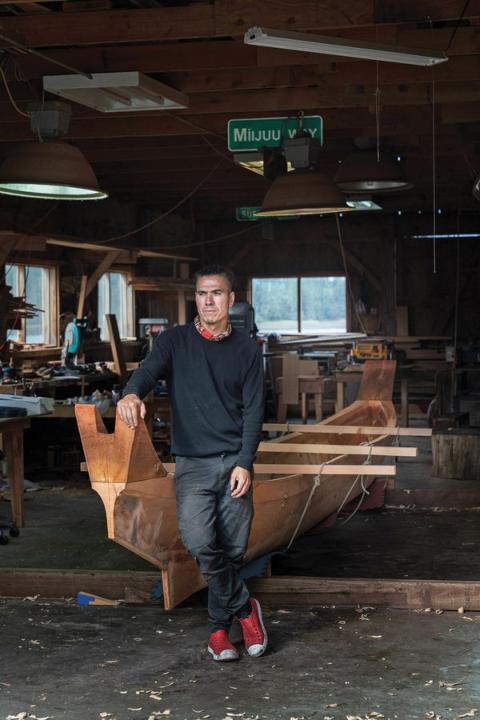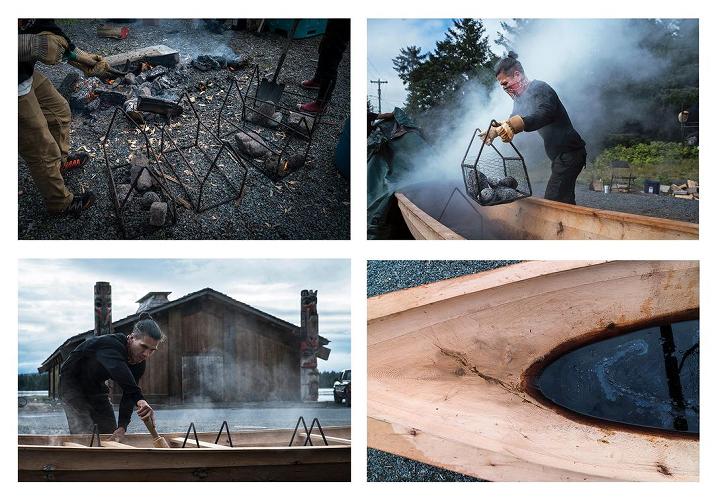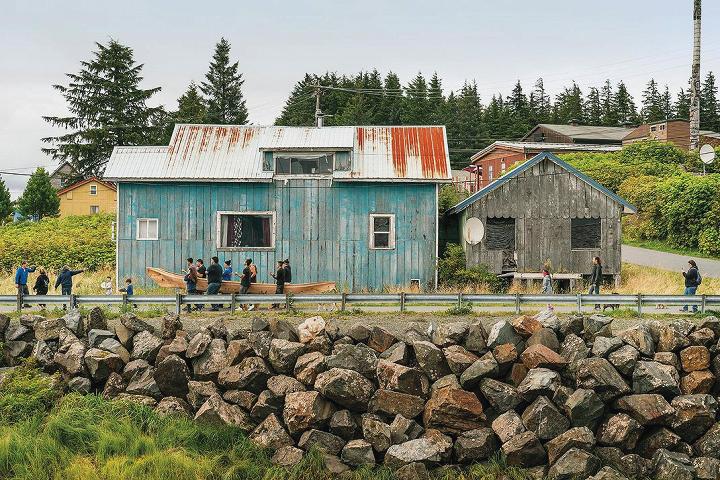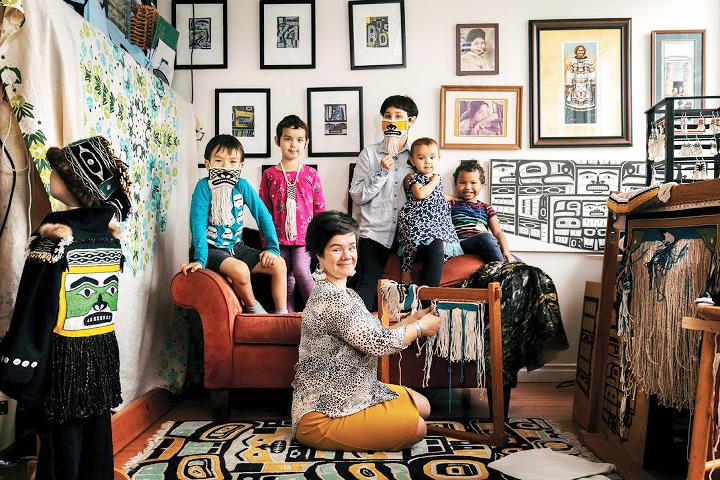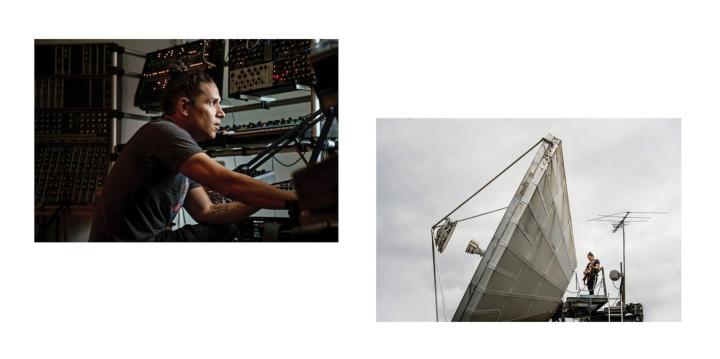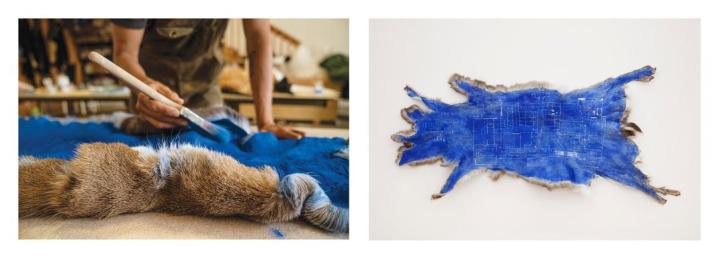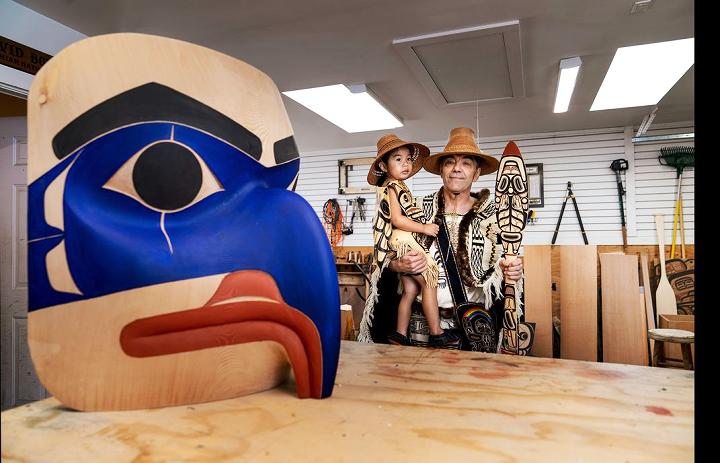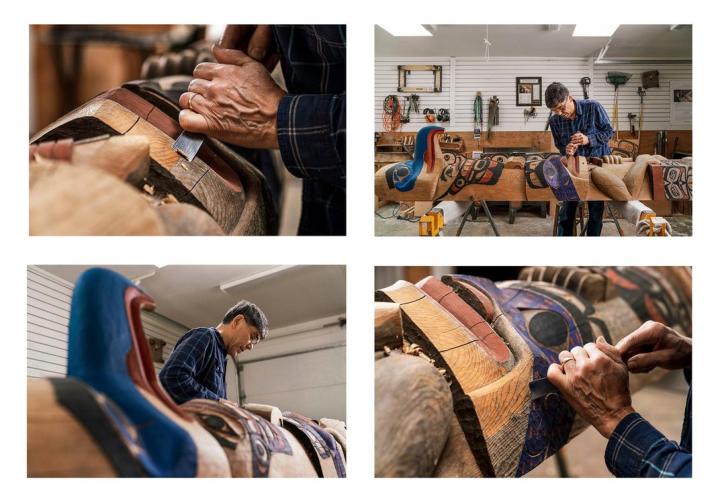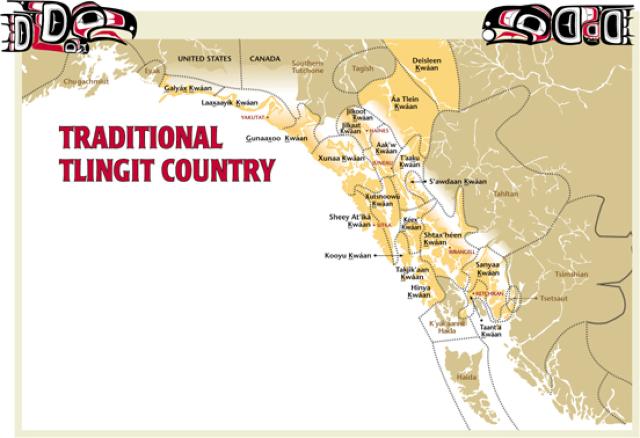|
In Indigenous communities
along the coast, a lively artistic movement plays with tradition
|
|
|
Nathan Jackson, a Chilkoot Sockeye clan leader,
in front of a Beaver Clan house screen that adorns a longhouse
at Saxman Totem Park. The house screen was carved on vertical
cedar planks before it was raised and assembled on the house
front. Jackson, who led the project, found his way back to
his heritage circuitously after a boyhood spent at a boarding
school that prohibited native languages and practices. (Fernando
Decillis)
|
Among the indigenous nations of Southeast Alaska, there is a concept
known in Haida as Íitl’ Kuníisii—a timeless
call to live in a way that not only honors one’s ancestors
but takes care to be responsible to future generations.
The traditional arts of the Haida, Tlingit and Tsimshian people
are integral to that bond, honoring families, clans, and animal
and supernatural beings, and telling oral histories through totem
poles, ceremonial clothing and blankets, hand-carved household items
and other objects. In recent decades, native artisans have revived
practices that stretch back thousands of years, part of a larger
movement to counter threats to their cultural sovereignty and resist
estrangement from their heritage.
They use materials found in the Pacific rainforest and along the
coast: red cedar, yellow cedar, spruce roots, seashells, animal
skins, wool, horns, rock. They have become master printmakers, producing
bold-colored figurative designs in the distinctive style known as
“formline,” which prescribes the placement of lines, shapes
and colors. Formline is a visual language of balance, movement,
storytelling, ceremony, legacy and legend, and through it, these
artisans bring the traditions of their rich cultures into the present
and ensure their place in the future.
|
|
|
A carver of monumental art, Nathan Jackson
works with a tool pictured below, called an adze. Jackson,
who also goes by Yéil Yádi, his Tlingit name,
carves a cedar panel depicting an eagle carrying a salmon
in its talons. (Fernando Decillis)
|
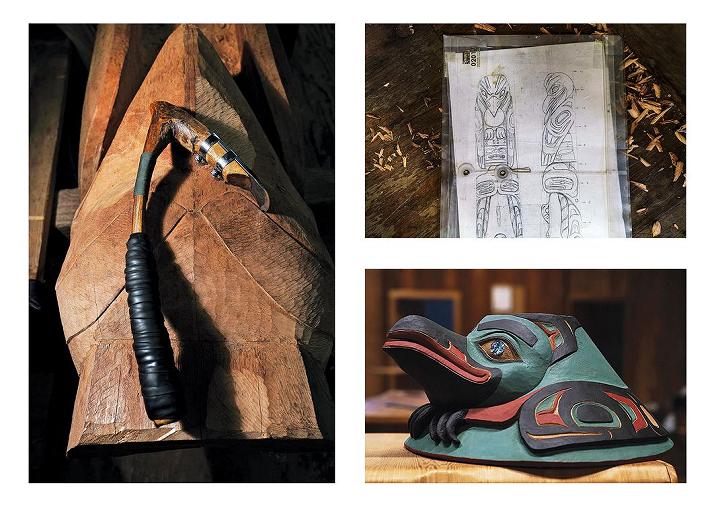 |
|
Clockwise from left: Jackson's adze. Above
right, formline designs drawn on paper will be laid out on
a twelve-foot totem pole before carving; a raven helmet, inlaid
with abalone shell. (Fernando Decillis)
|
|
|
|
At the Totem Heritage Center in Ketchikan,
Alaska, Jackson wears ceremonial blankets and a headdress
made from ermine pelts, cedar, abalone shell, copper and flicker
feathers. (Fernando Decillis)
|
|
|
|
Alison Bremner apprenticed with the master
carver David A. Boxley, a member of the Tsimshian tribe. She
is thought to be the first Tlingit woman to carve and raise
a totem pole, a feat she accomplished in her hometown, Yakutat,
Alaska. Now based in Juneau, she creates woodcarvings, paintings,
mixed-media sculpture, ceremonial clothing, jewelry, digital
collage and formline prints. Her work is notable for wit and
pop culture references, such as a totem pole with an image
of her grandfather holding a thermos, or a paddle bearing
a tiny nude portrait of Burt Reynolds in his famous 1970s
beefcake pose. (Fernando Decillis)
|
|
|
|
Alison Bremner's silkscreen work titled Decaf/Regular.
(Alison Bremner / Courtesy Steinbrueck / Native Gallery)
|
|
Sgwaayaans, a Kaigani Haida artist, carved
his first totem pole at age 19. Last year, he made his first
traditional canoe, from a red cedar estimated to be 300 years
old. Once the canoe was carved, it was taken outside to a
lot near the Hydaburg River. (Fernando Decillis)
|
|
|
|
|
Clockwise from left: canoe builder Sgwaayaans
and his apprentices heat lava rocks that will be used to steam
the wood of a traditional dugout canoe; the heated lava rocks
are lowered into a saltwater bath inside it, to steam the
vessel until it is pliable enough to be stretched crosswise
with thwarts; more than 200 tree rings in the Pacific red
cedar are still visible with the canoe in its nearly finished
form; Sgwaayaans strategically inserts the crosswise thwarts
and taps them into place with a round wooden mallet to create
the desired shape. (Francisco Decillis)
|
|
|
|
Haida community members then carried the canoe
back to the carving shed. Historically, the Haida were famous
for their giant hand-carved canoes; a single vessel was known
to carry 60 people or ten tons of freight. (Francisco Decillis)
|
|
|
|
Lily Hope, a designer of Chilkat and Ravenstail
textiles, lives in Juneau with her five children. She is seen
weaving Tlingit masks during the Covid-19 pandemic. Hope is
well known for her ceremonial robes, woven from mountain goat
wool and cedar bark, and often made for clan members commemorating
a major event like a birth, or participating in the mortuary
ceremony known as Ku.éex, held one year after a clan
member’s death. An educator and a community leader, Hope
also receives “repatriation commissions” from institutions
that return a historical artifact to its clan of origin and
replace it with a replica or an original artwork. (Fernando
Decillis)
|
|
|
|
Tlingit masks woven by Lily Hope during
the Covid-19 pandemic. (Fernando Decillis)
|
|
|
|
Nicholas Galanin, a Sitka-based artist and
musician, draws on his native heritage to create conceptual
artworks that diverge from tradition while also commenting
on it. Examples include ceremonial masks carved from anthropology
textbooks and a totem pole covered in the same wallpaper as
the gallery wall on which it hangs, causing it to nearly disappear.
(Fernando Decillis)
|
|
|
|
Architecture of Return, Escape (Metropolitan
Museum of Art), Nicholas Galanin's map of the Met on a deer
hide. It shows in red paint where the “Art of Native
America” exhibition’s 116 artworks are located and
suggests a route for them to “escape” from the museum
and “return” to their original homes. (Fernando
Decillis; Courtesy the artist and Peter Blum Gallery, New
York, 2020)
|
|
|
|
Tsimshian culture bearer David A. Boxley with
his grandson Sage in his carving studio in Lynwood, Washington.
An oversize eagle mask used for dance ceremonies and performances
sits on the workbench. (Fernando Decillis)
|
|
|
|
David A. Boxley carefully restores a cedar
house pole that commemorates his journey as a father bringing
up his sons David Robert and Zachary in the Tsimshian culture.
(Fernando Decillis)
|

| About the Author: Fernando Decillis works primarily in the
United States and in Colombia, as both an editorial and advertising
photographer. His clients have included Coca-Cola and Reebok,
and his work has appeared in Vanity Fair and Bloomberg Businessweek
among others. Read
more articles from Fernando Decillis |

Alaska
Native Knowledge Network (ANKN)
The Alaska Native Knowledge Network (ANKN) is an AKRSI partner designed
to serve as a resource for compiling and exchanging information
related to Alaska Native knowledge systems and ways of knowing.
It has been established to assist Native people, government agencies,
educators and the general public in gaining access to the knowledge
base that Alaska Natives have acquired through cumulative experience
over millennia. Anyone wishing to participate in the Alaska Native
Knowledge Network or contribute to the development of the resources
in this knowledge base is encouraged to contact us at (907) 474-5897,
or email fyankn@ankn.uaf.edu.
Our offices are located at UAF's Bunnell Building, Room 117 in Fairbanks,
Alaska. We welcome you to drop by in person and browse our curriculum
libraries or check out our newest publications.
http://www.ankn.uaf.edu/index.html
|




